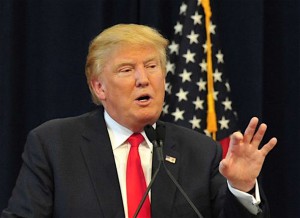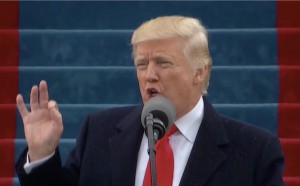
President Trump signed an executive order today ending the country's potential participation the Trans-Pacific trade deal.
President Donald Trump signed an executive order announcing his plan to withdraw the U.S. from the Trans-Pacific Partnership trade negotiations, which effectively kills one of the few Obama administration proposals backed by Republican Congress.
Trump also re-iterated his plans to re-negotiate the North American Free Trade Agreement. Both moves indicate Trump views his stance on ending support for free trade as one of the most popular elements of Presidential program.
It also shores up his support among perhaps the most restless part of his blue-collar base, workers in manufacturing industries in the Rust Belt states.
Trump promised to abandon the Pacific Rim trade deal early in his administration. Bernie Sanders also attacked TPP while Hillary Clinton promised to review the agreement to insure it did not lead to an exodus of jobs from the U.S. TPP never came up for vote in Congress despite bipartisan support for the pact.
(President Trump jumps on NAFTA before inaugural speech ends. For more, Click Here.)
The order killing TPP is also offered Trump an opportunity to pay back the Ford Motor Co. for its Trump-friendly announcement at the beginning of January when the automaker said it would kill plans for a $1.6-billion assembly plant in Mexico and create 700 jobs in suburban Detroit to develop a base for building electric vehicles and self-driving cars.
Ford had been a major critic of TPP, which the company said did not go anywhere near far enough in curbing currency manipulation by the Japanese.
“We’ve been talking about this for a long time,” Trump said after signing the order in the Oval Office, adding that leaving the 12-nation pact is a “great thing for the American worker.”
President Barack Obama argued that the TPP, which would have created a broad trading area throughout the Pacific Region, stretching from Southeast Asia to Latin America that could help deter the expansion of China’s economic influence around the Pacific Basin, which is the fastest growing part of the global economy.

President Donald Trump didn't waste any time jumping into governing, issuing a call to renegotiate NAFTA before his inaugural speech ended.
The TPP also would have excluded North Korea and Vladimir Putin’s Russian Federation.
(Trump threatens Canada, Mexico, with new border tariffs. Click Here for the story.)
The opening of discussions on changing the terms of NAFTA, another of Trump’s trade initiatives, is also expected during the new President’s first 100 days in office.
“After 23 years, renegotiating NAFTA is not inherently bad. It all depends on changes made and any timelines that are applied. Immediate applications of tariffs would be damaging to all parties,” noted Rebecca Lindland, an analyst for Kelley Blue Book.
“Tariffs imposed over time would potentially be less so. Incentives to build new plants in the U.S. also play a role in offsetting investment costs or other expenses created by changes to NAFTA. There are a lot of moving parts here and a lot of uncertainty.”
Lindland, however, said the potential for unintended consequences is huge.
“At the end of the day, though, Trump and his many of advisors are successful business people. Having them begin a review of NAFTA does not necessarily spell doomsday for the auto industry,” she said.
(Scrubbing NAFTA could cost 30,000 jobs, study finds. Click Here for the story.)
Trump is also expected to announce the opening of some kind of discussions on trade with Great Britain, pending the United Kingdom’s exit from the European Union when British Prime Minister Theresa May visits Washington D. C. this week.

Great.
Hmmm.